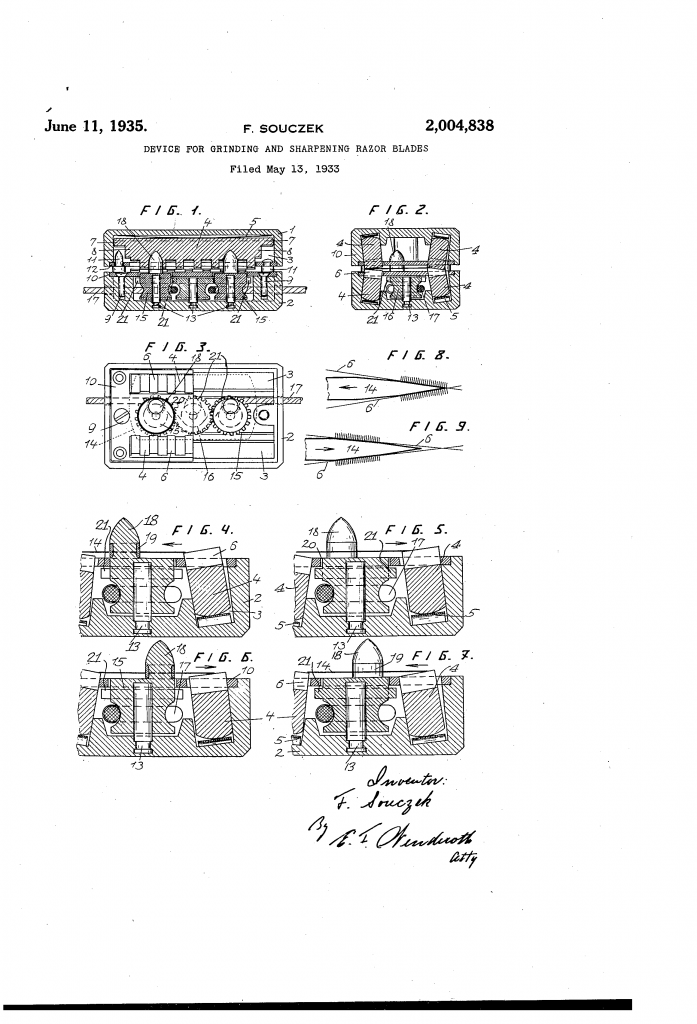A couple of days ago I shared a video I found on the restoration of a Simens razor sharpener. And guess what? I’ve now found the patent for it. Filed by Ferdinand Souczeck in 1933, the patent was applied for in – as far as I can tell – Czechoslovakia, Austria, and USA.
I’m not sure if Ferdinand worked for Simens, of if they simply bought the rights of him. What I do know is that Simens must have manufactured the device in several places. The one I own is clearly marked as made in Sweden, while other examples I found online is marked with Austria, Japan, USA, USSR, and elsewhere.
Every invention is an attempt to solve a problem. But the problem Ferdinand tried to solve wasn’t to sharpen the blade per se – it was to sharpen it better. To qoute:
In known grinding devices of this type, the movement between the razor blade and the grinding agent which is necessary for the grinding is generally only rectilinear and of a definite type of stroke, regardless of whether it is parallel, inclined or perpendicular to the edge and whether a grindstone or grinding rolls are used. However, this type of grinding favors the production on the sides of the edge of the blade of grooves which make it difficult or even impossible to obtain a complete grinding of the sides of the edge. The grinding, moreover, results in subjecting the blades to an injurious bending stress.
From US patent 2,004,838
So according to Ferdinand, the problem with other razor blade sharpeners were that they were grinding in a linear back and forth motion. The solution, he claimed, would be to move the blade in a circular motion. And while other sharpeners did that, Ferdinand claimed they put a bending motion on the blade.
The solution Ferdinand came up with, and Simens manufactured, was a box with a string. You put your blade in the box, closed the lid, and pulled the string. And When you opened the box, your blade was sharper.

Inside the box is where the magic happened. As can be seen from the drawings, there are a far few things going on.
In one half of the box you have three gear wheels with pulleys. The two outermost ones have eccentric spindles. The string is wrapped around the pulleys.
On either side of these gearwheels are two spring loaded grinding members, set at an angle. A matching set of two grinding members are set in the opposite lid as well.
As can be seen, the blade is placed on the spindles. Once the box is closed, the grinding elements are pressed against the blade sides. And when the string is pulled, it rotates the gears, which in turn moves the blade in a circle.
Or as Ferdinand put it in the patent text:
When the razor blade is positioned on the carrier pins 18 and the device is closed, the blade prevents the inter-engagement of opposing grinding teeth and, under the opposite but equal spring forces constituting the grinding pressure, is accurately positioned centrally of the gap formed between the two halves of the casing by the collars on the guide pins I I when the grinding members on both sides are not overlapped by the razor blade to the same extent (see Figure 2).
From US patent 2,004,838
If now the somewhat tensioned operating cord 11 is pulled from side to side, or, in the case where the cord is stationary, the grinding device itself is reciprocated along the cord, the razor blade will execute a curvilinear movement in its own plane.
There is, of course, a few differences between the device as patented, and the device as built. The big one is in the shape and position of the grinding members. Whereas the patent shows them with a flat top and set at an angle, my Simens sharpener (and every other one I’ve seen pictures of) has them with an angled top and set straight in the box.
Unlike so many of the patents I discuss, this one was quite successful. If you search for “razor blade sharpener” online today, a lot of your results will be of the Simens razor blade sharpener. It was successful enough that an Albert B Swanson filed a patent for what was basically an electric version of it in 1958.
Today, we are often told, you shouldn’t sharpen a regular razor blade. But if you needed to, a Simens razor blade sharpener would be just the thing to do it with.
You can read the full patent for Simens razor blade sharpener on Google Patents.
